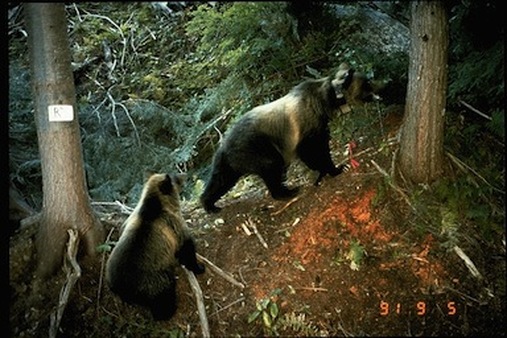The US Ninth Court of Appeals recently ruled that Grizzly Bears in the Yellowstone area must remain protected as an threatened species under the Endangered Species Act, because a main food source for the largest mammal of our North American forests is being wiped out by pine beetle and drought, maladies laid at the feet of climate change. Until the US FWS can establish a measure of the threat posed by the complex relationship between the grizzly and its important Autumn food source in white pine nuts, the bear will remain listed.
It's an example of the depth and complexity of the problem of habitat before us -- rapid climate change leading to swaths of dead habitat throughout a region the size of South Carolina, leaving the wildlife of the area without a vital source food at a time of feeding for winter. How do we preserve a forest, a habitat of such size as the Greater Yellowstone Ecosystem, much less an Arctic habitat for the polar bear. The size of change taking place with climate change is truly unfathomable; that it is happening at a rate several times faster than what was predicted should chill us all. But this change is largely out of sight of the mainstream urban populations, thus 37 percent of Americans maintain that climate change is a figment of scientists' imaginations, a number largely unchanged since last May, in a study by the Yale Project on Climate Change Communications. "A Gallup poll from last month found that Americans rated global warming as the environmental problem they worry about the least," noted US News in August 2011.
Perhaps one of these Americans could explain this disbelief to a starving grizzly bear in the Yellowstone area. Pregnant females are needing to eat high calorie foods to survive a winter of bearing her young. The bear is an amazing animal -- if the female runs out of sufficient calories while hibernating, her young do not make it to term within her. If there are barely calories enough to carry to term, the female can easily starve while the young are born, nursing as she still hibernates before the spring thaws of the high mountains reach her snow-bound den, rousing her to search for food. The grizzly is a beautiful creatures and one is lucky to ever get to watch their care of their young in the wild, as I was once honored to see on an early morning in Yellowstone. On an early June morning, a female gently swatted her lagging, playful cubs into rolling balls of fur over the far mountain meadow, urging them to the safety of the white pine forest before the sun and danger of discovery rose any higher. In seeing such moments, the breath stopes at seeing and feeling the wild thrive in our ruled and paved world; we will be poorer without the bears, or the vast pine forests, or the complex web of habitat and wildlife it supports.
http://www.fws.gov/mountain-prairie/pressrel/11-71.htmlhttp://www.actionbioscience.org/environment/loganmacfarlane.html
http://environment.yale.edu/climate/
http://www.usnews.com/news/articles/2011/04/27/do-americans-care-about-climate-change-anymore
It's an example of the depth and complexity of the problem of habitat before us -- rapid climate change leading to swaths of dead habitat throughout a region the size of South Carolina, leaving the wildlife of the area without a vital source food at a time of feeding for winter. How do we preserve a forest, a habitat of such size as the Greater Yellowstone Ecosystem, much less an Arctic habitat for the polar bear. The size of change taking place with climate change is truly unfathomable; that it is happening at a rate several times faster than what was predicted should chill us all. But this change is largely out of sight of the mainstream urban populations, thus 37 percent of Americans maintain that climate change is a figment of scientists' imaginations, a number largely unchanged since last May, in a study by the Yale Project on Climate Change Communications. "A Gallup poll from last month found that Americans rated global warming as the environmental problem they worry about the least," noted US News in August 2011.
Perhaps one of these Americans could explain this disbelief to a starving grizzly bear in the Yellowstone area. Pregnant females are needing to eat high calorie foods to survive a winter of bearing her young. The bear is an amazing animal -- if the female runs out of sufficient calories while hibernating, her young do not make it to term within her. If there are barely calories enough to carry to term, the female can easily starve while the young are born, nursing as she still hibernates before the spring thaws of the high mountains reach her snow-bound den, rousing her to search for food. The grizzly is a beautiful creatures and one is lucky to ever get to watch their care of their young in the wild, as I was once honored to see on an early morning in Yellowstone. On an early June morning, a female gently swatted her lagging, playful cubs into rolling balls of fur over the far mountain meadow, urging them to the safety of the white pine forest before the sun and danger of discovery rose any higher. In seeing such moments, the breath stopes at seeing and feeling the wild thrive in our ruled and paved world; we will be poorer without the bears, or the vast pine forests, or the complex web of habitat and wildlife it supports.
http://www.fws.gov/mountain-prairie/pressrel/11-71.htmlhttp://www.actionbioscience.org/environment/loganmacfarlane.html
http://environment.yale.edu/climate/
http://www.usnews.com/news/articles/2011/04/27/do-americans-care-about-climate-change-anymore

 RSS Feed
RSS Feed
